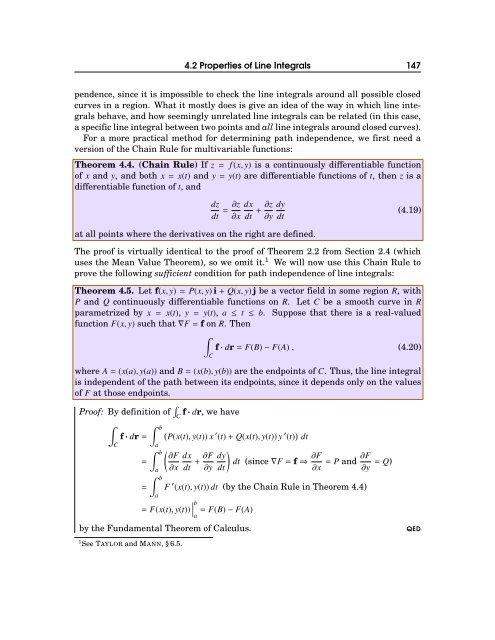Michael Corral: Vector Calculus
Michael Corral: Vector Calculus
Michael Corral: Vector Calculus
Create successful ePaper yourself
Turn your PDF publications into a flip-book with our unique Google optimized e-Paper software.
4.2 Properties of Line Integrals 147<br />
pendence, since it is impossible to check the line integrals around all possible closed<br />
curves in a region. What it mostly does is give an idea of the way in which line integrals<br />
behave, and how seemingly unrelated line integrals can be related (in this case,<br />
aspecificlineintegralbetweentwopointsandalllineintegralsaroundclosedcurves).<br />
For a more practical method for determining path independence, we first need a<br />
version of the Chain Rule for multivariable functions:<br />
Theorem 4.4. (Chain Rule) If z= f(x,y) is a continuously differentiable function<br />
of x and y, and both x= x(t) and y=y(t) are differentiable functions of t, then z is a<br />
differentiable function of t, and<br />
dz<br />
dt =∂z dx<br />
∂x dt +∂z dy<br />
∂y dt<br />
(4.19)<br />
at all points where the derivatives on the right are defined.<br />
The proof is virtually identical to the proof of Theorem 2.2 from Section 2.4 (which<br />
uses the Mean Value Theorem), so we omit it. 1 We will now use this Chain Rule to<br />
prove the following sufficient condition for path independence of line integrals:<br />
Theorem 4.5. Let f(x,y)=P(x,y)i+Q(x,y)j be a vector field in some region R, with<br />
P and Q continuously differentiable functions on R. Let C be a smooth curve in R<br />
parametrized by x = x(t), y = y(t), a ≤ t ≤ b. Suppose that there is a real-valued<br />
function F(x,y) such that∇F= f on R. Then<br />
∫<br />
f·dr=F(B)−F(A), (4.20)<br />
C<br />
where A=(x(a),y(a)) and B=(x(b),y(b)) are the endpoints of C. Thus, the line integral<br />
is independent of the path between its endpoints, since it depends only on the values<br />
of F at those endpoints.<br />
Proof: By definition of ∫ C f·dr, we have<br />
∫ ∫ b<br />
(<br />
f·dr= P(x(t),y(t))x ′ (t)+Q(x(t),y(t))y ′ (t) ) dt<br />
C<br />
=<br />
a<br />
∫ b<br />
a<br />
∫ b<br />
( ∂F<br />
∂x<br />
dx<br />
dt +∂F ∂y<br />
)<br />
dy<br />
dt (since∇F= f⇒ ∂F<br />
dt ∂x = P and∂F ∂y = Q)<br />
= F ′ (x(t),y(t))dt (by the Chain Rule in Theorem 4.4)<br />
a<br />
= F(x(t),y(t))<br />
∣ b = F(B)−F(A)<br />
a<br />
by the Fundamental Theorem of <strong>Calculus</strong>.<br />
QED<br />
1 See TAYLOR and MANN, §6.5.








